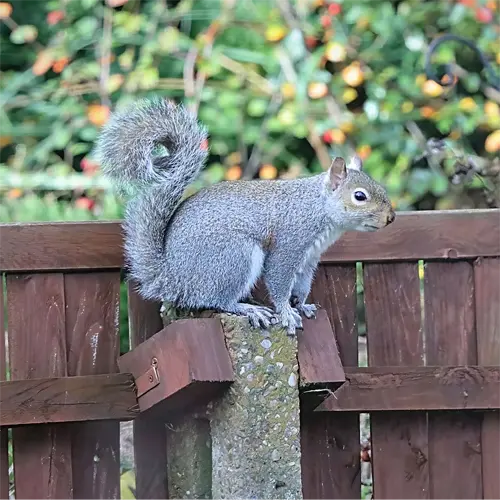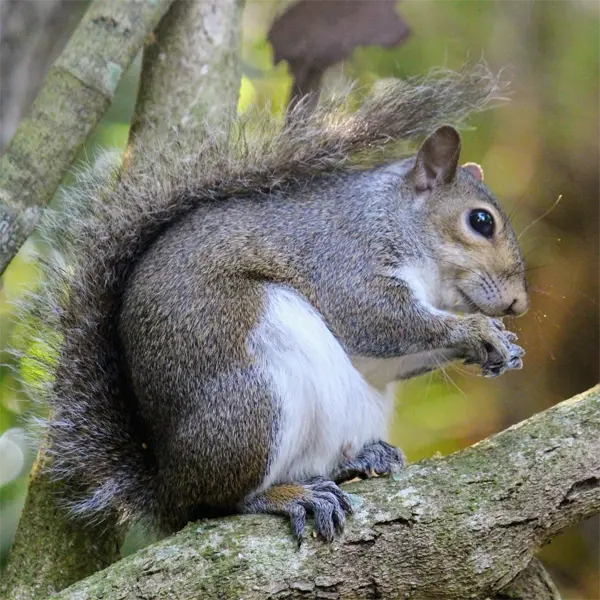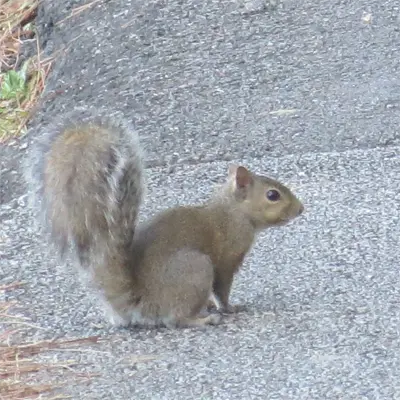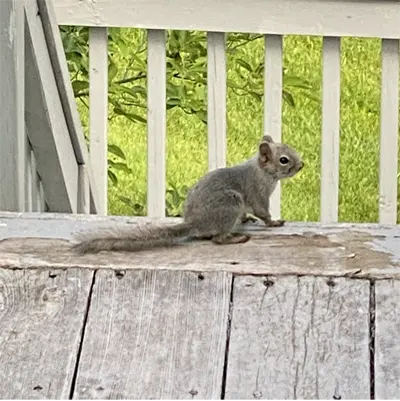Eastern Gray Squirrels in Central Florida
The eastern gray squirrel (Sciurus carolinensis) is a prolific tree squirrel native to eastern North America. In central Florida, eastern gray squirrels thrive in urban and suburban neighborhoods where they frequently interact with humans. This adaptable rodent is recognized by its predominantly gray fur and large bushy tail.
While eastern grays provide entertainment to some, they can also cause frustrations by nesting in attics and gnawing on property. Read on to learn about eastern gray squirrel identification, biology, behavior, health risks, and control methods relevant to central Florida homeowners.
Eastern Gray Squirrel Subspecies
Photo 28314467 (c) Steve Hofhine, CC BY-NC
Florida Gray Squirrel
The Florida gray squirrel is a subspecies of the eastern gray squirrel found only in certain areas of Florida. Its range centers on oak-cabbage palm hammocks and freshwater marshes in central and southern parts of the state.
Compared to other eastern gray squirrels, the Florida gray is smaller in size and has more gray fur overall. Within Florida, it is one of the smaller tree squirrel species. Research indicates the Florida population is genetically unique and adapted to the tropical hardwood hammocks and wetlands found in its range.
Due to its limited area in Florida and distinct genetics, the Florida gray squirrel is an important subspecies to conserve in the state.
Appearance and Identification
Eastern Gray Squirrels can be distinguished from other tree squirrels by their size and coloration
The combination of largely gray fur, bushy tail, and excellent climbing adaptions separate the eastern gray from fox squirrels and southern flying squirrels in central Florida.
Maturation Rate
Baby eastern gray squirrels develop rapidly under the warm central Florida climate. Their fur grows in after about 3 weeks. Eyes open and ears unfold at around 4 weeks old.
By 6 to 8 weeks, juveniles are starting to explore outside the nest and nibble on solid foods. Weaning is usually complete by 10 weeks as they learn to forage.
Young squirrels reach adult size by 16 to 20 weeks old. They leave the nest and establish independent territories by that time. Reproductive maturity occurs by 1 year of age.
Habits and Behavior
Eastern gray squirrels are diurnal, most active in the early morning and late afternoon. They do not hibernate but may spend prolonged periods in nests during harsh weather. Eastern grays inhabit mixed stands of trees in urban parks, wooded suburban neighborhoods, and residential areas with mature trees.
These agile squirrels readily climb trees, fences, utility poles, and bird feeders in their range. They construct nests called dreys high in tree branches by weaving together leaves, twigs, bark strips, and other materials. Nests are lined with moss, thistle, feathers, or shredded bark for insulation.
Eastern grays are territorial. They defend their nesting sites from intruders but share larger home ranges. Noisy chattering, tail flicking, and chasing are part of territorial displays.
Reproduction and Lifespan
In central Florida, eastern gray squirrels can breed year-round and produce 2-3 litters annually. Females enter estrus cycles every 25 days if not pregnant. This allows multiple litters.
Breeding peaks in December to February and May to June in Florida. The gestation period is 44 to 45 days. Typical litter size is 3 to 4 young, born pink, hairless, and toothless.
Young open their eyes at around 4 weeks old. They are weaned and start venturing from the nest at 8 to 10 weeks. Eastern grays reach sexual maturity by 1 year old. Lifespan is typically 6 to 12 years in the wild.
Ideal Habitat and Range
Central Florida’s humid, subtropical climate provides favorable habitat for eastern gray squirrels to flourish. Average annual temperatures range from the low 70sF (22C) around Orlando to the upper 70sF (25C) in Miami. Summer highs reach the 90sF (30sC). Rainfall averages 50 to 60 inches (1270 to 1520 mm) per year with pronounced wet and dry seasons.
Mixed oak hammocks, pine flatwoods, cypress swamps, and sabal palm forests surround urban developments. Lush vegetation, agricultural crops, mature trees, and abundant fresh water support large squirrel populations. The mild winters allow year-round breeding.
Developed areas offer additional food sources like tree buds, seeds, fruits, flowers, pet food, and unsecured garbage. Attics, crawlspaces, eaves, and dense trees provide nesting sites. The high heat and humidity also accelerates decomposition for caching uneaten foods.
Diet and Feeding
Eastern gray squirrels have an extremely varied omnivorous diet. Food sources include:
- Trees – seeds, buds, flowers, twigs, bark. Favorites are pine, maple, oak, walnut, hickory.
- Fungi – mushrooms, lichens, bracket fungi.
- Fruits – citrus, berries, palm dates.
- Insects – caterpillars, beetles, cicadas.
- Bird eggs and nestlings.
- Corn and other crops.
- Pet food, bird seed, garbage.
Eastern grays spend mornings actively foraging and evenings caching excess foods. They disperse seeds and spores through the environment. Large amounts are buried in shallow caches for later recovery using spatial memory. Eastern grays help control insect pests but also damage gardens, crops, and structures.
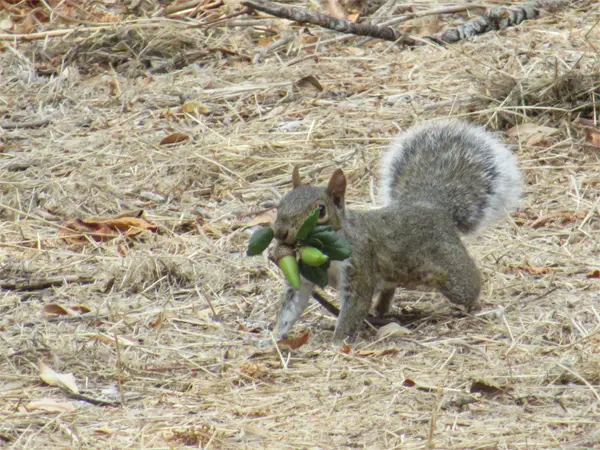

Common Health Risks
Although not major carriers of zoonotic diseases, eastern gray squirrels can potentially transmit:
- Salmonellosis – spread through feces. Causes diarrhea, fever, and cramps.
- Ringworm – skin infection spread by contact with infected squirrels. Causes ring-shaped rash.
- Tularemia – bacterial disease spread by tick and flea bites. Causes fever, ulcers, pneumonia.
Eastern grays also introduce ticks, fleas, and mites into homes if nesting in attics. Allergens like dander, urine, and droppings accumulating in enclosed spaces aggravate asthma.
Tree squirrels are a primary host of the eastern equine encephalitis virus, which can cause severe neurological disease in humans via mosquitoes. Prompt nest removal and exclusion helps reduce contact risks.
Preventing Eastern Gray Squirrel Infestations
The primary control method is excluding eastern gray squirrels from buildings and denying access. This involves:
- Conducting thorough inspections to locate any possible entry points on structures. Look for openings wider than 1 inch, which squirrels can squeeze through.
- Sealing all holes, gaps, and vents with durable materials like steel mesh, copper, cement, hardware cloth, or metal sheeting. Pay particular attention to roof edges, eaves, attic vents, and openings where wires or pipes enter.
- Installing exclusion guards on vulnerable areas like chimneys, fascia boards, gable vents, and weep holes. Chimney caps, vent covers, and perforated metal can be applied.
- Pruning tree branches back at least 10 feet from the building. Squirrels use these as launching points.
- Removing exterior climbing fixtures near the roofline like pipes, wires, and light fixtures.
- Ensuring attic doors/hatches and crawl space vents are securely closed off.
- Clearing bushes, landscaping materials, and debris away from building exteriors to eliminate nesting sites.
- Hiring a professional pest control company to identify and seal off all possible entry points.
Other tactics include trapping, population reduction with approved wildlife management techniques, and managing food attractants. Consult a professional pest control company or wildlife authority for humane squirrel removal guidance.
Eastern Gray Squirrels in Central Florida – Conclusion
The eastern gray squirrel is a pervasive tree squirrel ideally suited to central Florida’s warm climate and urban forests. While sometimes considered pests, proper exclusion and population management can prevent problems.
Understanding their typical habits, biology, and risks allows informed decision making if gray squirrels become a nuisance on your property. With proactive prevention, eastern grays can be appreciated from afar for their beauty and agility without sharing your living spaces.

